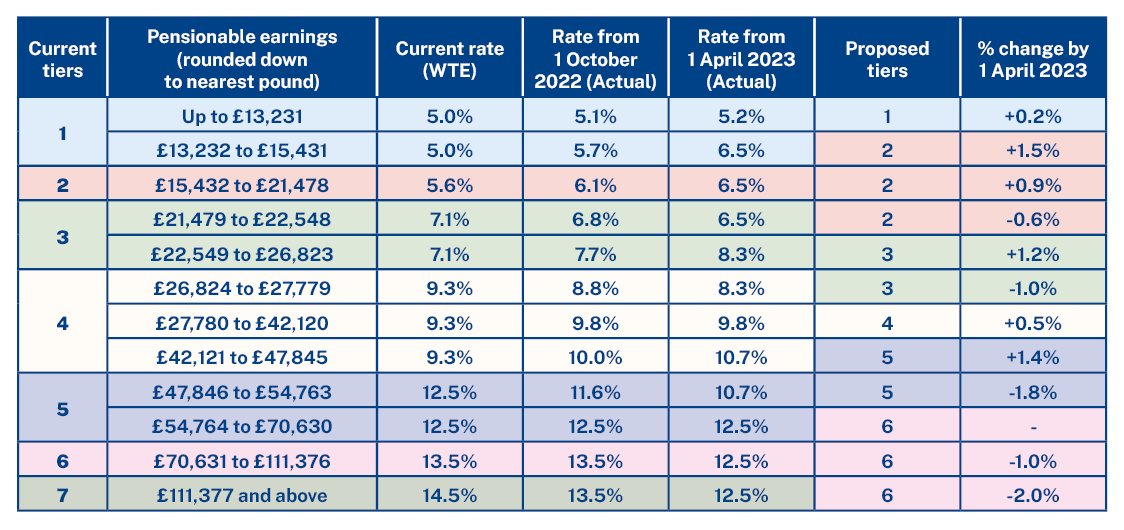Contribution changes to the NHS Pension
England and Wales only
At the end of last year the Department of Health and Social Care (DHSC) launched a public consultation on proposals to change the contribution rates for the NHS Pension Scheme in England and Wales.
The RCN responded to the consultation, based on members’ input. Some of the concerns we raised were recognised by the government, namely the perceived inequality of the changes benefiting those at the top of the pay structure.
The outcome of the consultation is available here with planned increases now due to be phased in from 1 October 2022 – the original proposal had been to implement from April 2022.
NHS Pension contribution changes?
The amount you pay into the NHS Pension Scheme is based on your pensionable earnings or whole-time equivalent if you work part time. Contribution rates are currently tiered as shown in the table below:

Pension contribution rates should be reviewed every four years after a scheme valuation has been undertaken. This is to ensure that the amount of money coming into the scheme from active members (the yield) is adequate. The most recent valuation has confirmed the yield to be 9.8%.
The current contribution framework has been in place since 2015. It was due to be revised in 2019 but, due to pressure from the RCN and other NHS trade unions, the DHSC agreed to delay changes until at least 2021 so that any changes did not undermine the value of the 2018 three-year pay deal.
Historically, the NHS Pension Scheme has always had differential levels of contributions according to members’ income and some degree of this is retained in this proposal.
Following consultation, the DHSC has determined to implement the following changes from 1 October 2022.
Move to actual pensionable pay
The framework above will change to allow future contributions to be based on actual pensionable pay rather than members’ whole-time equivalent.
The tier of contributions someone currently pays is based on their whole-time equivalent pensionable pay. This can mean that part-time staff pay a higher percentage than they would if pension contributions were based on the actual amount they earn. This is illustrated by NHS pensions here.
Pensionable pay includes all regularly received payments – so includes unsocial hours, high-cost area supplements but not overtime. Further information about pensionable pay can be found here. Information about the way contributions are currently worked out can be found here and on an NHS Business Services Authority video here.
Indexing
The current member contribution framework does not change to take into account the effect of annual pay awards. This means some members move to a higher contribution tier when their pay increases and this is likely to be the case for some members following the back payment of the 2022/23 pay award. As a result, some members will not receive the full value of their pay award because of increases to their pension contribution rate.
However, the new framework (from October 2022) will build in an indexing mechanism so that contribution tiers will be uprated as pay awards are made so as to prevent 'cliff edges'. This change would only apply to pay increases due to the annual pay award from government. Therefore, if you earn more due to a pay step increase or promotion, your tier will still be recalculated.
Bank staff
Members who routinely do work on the bank will have their contribution rate based on their previous year’s annual rate of pensionable pay. Guidance will be provided to employers to help them determine the appropriate rate for bank staff in their first year doing bank work, based on an estimate of the likely earnings over the course of the pension scheme year.
Changes to be implemented over two years
The contribution changes will be postponed and the regulations, including amendments to give effect to the changes to the proposals, will be laid before Parliament and come into force on 1 October 2022. Acknowledging the difference these changes will have on scheme members, the DHSC proposes to phase them in over two years.
What might this look like for me?
Remember: pension contributions attract tax relief, so the amount you actually pay is less than the figure above.
There are separate changes related to the scheme that come into effect on the 1 April 2022. For further information, please see our guide on age discrimination in reformed public service pension schemes.







